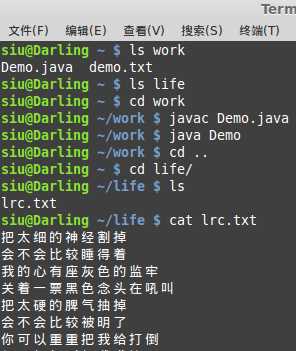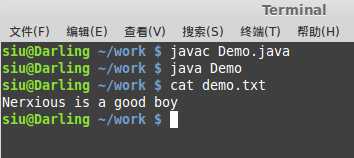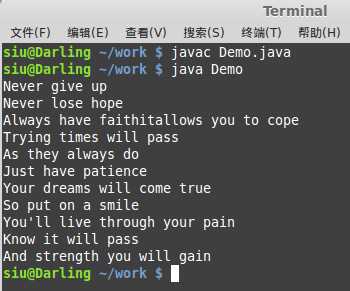I/O操作总结
Posted
tags:
篇首语:本文由小常识网(cha138.com)小编为大家整理,主要介绍了I/O操作总结相关的知识,希望对你有一定的参考价值。
所谓IO,也就是Input与Output的缩写。在java中,IO涉及的范围比较大,这里主要讨论针对文件内容的读写
其他知识点将放置后续章节(我想,文章太长了,谁都没耐心翻到最后)
对于文件内容的操作主要分为两大类
分别是:
字符流
字节流
其中,字符流有两个抽象类:Writer Reader
其对应子类FileWriter和FileReader可实现文件的读写操作
BufferedWriter和BufferedReader能够提供缓冲区功能,用以提高效率
同样,字节流也有两个抽象类:InputStream OutputStream
其对应子类有FileInputStream和FileOutputStream实现文件读写
BufferedInputStream和BufferedOutputStream提供缓冲区功能
俺当初学IO的时候犯了不少迷糊,网上有些代码也无法通过编译,甚至风格都很大不同,所以新手请注意:
1.本文代码较长,不该省略的都没省略,主要是因为作为一个新手需要养成良好的代码编写习惯
2.本文在linux下编译,类似于File.pathSeparator和File.separator这种表示方法是出于跨平台性和健壮性考虑
3.代码中有些操作有多种执行方式,我采用了方式1...方式2...的表述,只需轻轻解开注释便可编译
4.代码中并没有在主方法上抛出异常,而是分别捕捉,造成代码过长,如果仅是测试,或者不想有好的编程习惯,那你就随便抛吧……
5.功能类似的地方就没有重复写注释了,如果新手看不懂下面的代码,那肯定是上面的没有理解清楚
字符流
实例1:字符流的写入
|
1
2
3
4
5
6
7
8
9
10
11
12
13
14
15
16
17
18
19
20
21
22
23
24
25
26
27
28
29
30
31
32
33
34
35
36
37
38
39
|
import java.io.File;import java.io.FileWriter;import java.io.IOException;public class Demo { public static void main(String[] args ) { //创建要操作的文件路径和名称 //其中,File.separator表示系统相关的分隔符,Linux下为:/ Windows下为:\\\\ String path = File.separator + "home" + File.separator + "siu" + File.separator + "work" + File.separator + "demo.txt"; //由于IO操作会抛出异常,因此在try语句块的外部定义FileWriter的引用 FileWriter w = null; try { //以path为路径创建一个新的FileWriter对象 //如果需要追加数据,而不是覆盖,则使用FileWriter(path,true)构造方法 w = new FileWriter(path); //将字符串写入到流中,\\r\\n表示换行想有好的 w.write("Nerxious is a good boy\\r\\n"); //如果想马上看到写入效果,则需要调用w.flush()方法 w.flush(); } catch (IOException e) { e.printStackTrace(); } finally { //如果前面发生异常,那么是无法产生w对象的 //因此要做出判断,以免发生空指针异常 if(w != null) { try { //关闭流资源,需要再次捕捉异常 w.close(); } catch (IOException e) { e.printStackTrace(); } } } }} |
编译之后,在目录下面生成文件,并写入字符串

实例2:字符流的读取
|
1
2
3
4
5
6
7
8
9
10
11
12
13
14
15
16
17
18
19
20
21
22
23
24
25
26
27
28
29
30
31
32
33
34
35
36
37
38
39
40
41
42
43
44
45
46
47
48
49
50
51
52
53
54
55
56
57
58
59
60
61
62
63
64
65
66
67
68
69
70
71
72
73
74
|
import java.io.File;import java.io.FileReader;import java.io.IOException;public class Demo2 { public static void main(String[] args ) { String path = File.separator + "home" + File.separator + "siu" + File.separator + "work" + File.separator + "demo.txt"; FileReader r = null; try { r = new FileReader(path); //方式一:读取单个字符的方式 //每读取一次,向下移动一个字符单位 int temp1 = r.read(); System.out.println((char)temp1); int temp2 = r.read(); System.out.println((char)temp2); //方式二:循环读取 //read()方法读到文件末尾会返回-1 /* while (true) { int temp = r.read(); if (temp == -1) { break; } System.out.print((char)temp); } */ //方式三:循环读取的简化操作 //单个字符读取,当temp不等于-1的时候打印字符 /*int temp = 0; while ((temp = r.read()) != -1) { System.out.print((char)temp); } */ //方式四:读入到字符数组 /* char[] buf = new char[1024]; int temp = r.read(buf); //将数组转化为字符串打印,后面参数的意思是 //如果字符数组未满,转化成字符串打印后尾部也许会出现其他字符 //因此,读取的字符有多少个,就转化多少为字符串 System.out.println(new String(buf,0,temp)); */ //方式五:读入到字符数组的优化 //由于有时候文件太大,无法确定需要定义的数组大小 //因此一般定义数组长度为1024,采用循环的方式读入 /* char[] buf = new char[1024]; int temp = 0; while((temp = r.read(buf)) != -1) { System.out.print(new String(buf,0,temp)); } */ } catch (IOException e) { e.printStackTrace(); } finally { if(r != null) { try { r.close(); } catch (IOException e) { e.printStackTrace(); } } } }} |
编译之后的效果:

实例3:文本文件的复制
|
1
2
3
4
5
6
7
8
9
10
11
12
13
14
15
16
17
18
19
20
21
22
23
24
25
26
27
28
29
30
31
32
33
34
35
36
37
38
39
40
41
42
43
44
45
46
47
48
49
50
51
52
53
54
55
56
|
import java.io.File;import java.io.FileReader;import java.io.FileWriter;import java.io.IOException;public class Demo { public static void main(String[] args ) { String doc = File.separator + "home" + File.separator + "siu" + File.separator + "work" + File.separator + "demo.txt"; String copy = File.separator + "home" + File.separator + "siu" + File.separator + "life" + File.separator + "lrc.txt"; FileReader r = null; FileWriter w = null; try { r = new FileReader(doc); w = new FileWriter(copy); //方式一:单个字符写入 int temp = 0; while((temp = r.read()) != -1) { w.write(temp); } //方式二:字符数组方式写入 /* char[] buf = new char[1024]; int temp = 0; while ((temp = r.read(buf)) != -1) { w.write(new String(buf,0,temp)); } */ } catch (IOException e) { e.printStackTrace(); } finally { //分别判断是否空指针引用,然后关闭流 if(r != null) { try { r.close(); } catch (IOException e) { e.printStackTrace(); } } if(w != null) { try { w.close(); } catch (IOException e) { e.printStackTrace(); } } } }} |
编译之后,产生life目录下的lrc.txt文件,复制成功

实例4:利用字符流的缓冲区来进行文本文件的复制
|
1
2
3
4
5
6
7
8
9
10
11
12
13
14
15
16
17
18
19
20
21
22
23
24
25
26
27
28
29
30
31
32
33
34
35
36
37
38
39
40
41
42
43
44
45
46
47
48
49
50
51
52
53
54
55
56
57
58
59
60
61
62
63
64
65
|
import java.io.BufferedReader;import java.io.BufferedWriter;import java.io.File;import java.io.FileReader;import java.io.FileWriter;import java.io.IOException;public class Demo { public static void main(String[] args ) { String doc = File.separator + "home" + File.separator + "siu" + File.separator + "work" + File.separator + "demo.txt"; String copy = File.separator + "home" + File.separator + "siu" + File.separator + "life" + File.separator + "lrc.txt"; FileReader r = null; FileWriter w = null; //创建缓冲区的引用 BufferedReader br = null; BufferedWriter bw = null; try { r = new FileReader(doc); w = new FileWriter(copy); //创建缓冲区对象 //将需要提高效率的FileReader和FileWriter对象放入其构造函数内 //当然,也可以使用匿名对象的方式 br = new BufferedReader(new FileReader(doc)); br = new BufferedReader(r); bw = new BufferedWriter(w); String line = null; //读取行,直到返回null //readLine()方法只返回换行符之前的数据 while((line = br.readLine()) != null) { //使用BufferWriter对象的写入方法 bw.write(line); //写完文件内容之后换行 //newLine()方法依据平台而定 //windows下的换行是\\r\\n //Linux下则是\\n bw.newLine(); } } catch (IOException e) { e.printStackTrace(); } finally { //此处不再需要捕捉FileReader和FileWriter对象的异常 //关闭缓冲区就是关闭缓冲区中的流对象 if(br != null) { try { r.close(); } catch (IOException e) { e.printStackTrace(); } } if(bw != null) { try { bw.close(); } catch (IOException e) { e.printStackTrace(); } } } }} |
字节流
实例5:字节流的写入
|
1
2
3
4
5
6
7
8
9
10
11
12
13
14
15
16
17
18
19
20
21
22
23
24
25
26
27
28
29
30
31
32
33
34
|
import java.io.File;import java.io.FileOutputStream;import java.io.IOException;public class Demo { public static void main(String[] args ) { String path = File.separator + "home" + File.separator + "siu" + File.separator + "work" + File.separator + "demo.txt"; FileOutputStream o = null; try { o = new FileOutputStream(path); String str = "Nerxious is a good boy\\r\\n"; byte[] buf = str.getBytes(); //也可以直接使用o.write("String".getBytes()); //因为字符串就是一个对象,能直接调用方法 o.write(buf); } catch (IOException e) { e.printStackTrace(); } finally { if(o != null) { try { o.close(); } catch (IOException e) { e.printStackTrace(); } } } }} |
编译之后产生的文件,以上在字符串中加\\r\\n就是为了便于终端显示
其实在linux下面换行仅用\\n即可

实例6:字节流的读取
|
1
2
3
4
5
6
7
8
9
10
11
12
13
14
15
16
17
18
19
20
21
22
23
24
25
26
27
28
29
30
31
32
33
34
35
36
37
38
39
40
41
42
43
44
45
46
47
48
49
50
51
52
53
54
55
56
57
58
59
|
import java.io.File;import java.io.FileInputStream;import java.io.IOException;public class Demo { public static void main(String[] args ) { String path = File.separator + "home" + File.separator + "siu" + File.separator + "work" + File.separator + "demo.txt"; FileInputStream i = null; try { i = new FileInputStream(path); //方式一:单个字符读取 //需要注意的是,此处我用英文文本测试效果良好 //但中文就悲剧了,不过下面两个方法效果良好 int ch = 0; while((ch=i.read()) != -1){ System.out.print((char)ch); } //方式二:数组循环读取 /* byte[] buf = new byte[1024]; int len = 0; while((len = i.read(buf)) != -1) { System.out.println(new String(buf,0,len)); } */ //方式三:标准大小的数组读取 /* //定一个一个刚好大小的数组 //available()方法返回文件的字节数 //但是,如果文件过大,内存溢出,那就悲剧了 //所以,亲们要慎用!!!上面那个方法就不错 byte[] buf = new byte[i.available()]; i.read(buf); //因为数组大小刚好,所以转换为字符串时无需在构造函数中设置起始点 System.out.println(new String(buf)); */ } catch (IOException e) { e.printStackTrace(); } finally { if(i != null) { try { i.close(); } catch (IOException e) { e.printStackTrace(); } } } }} |
读取文件到终端

实例7:二进制文件的复制
|
1
2
3
4
5
6
7
8
9
10
11
12
13
14
15
16
17
18
19
20
21
22
23
24
25
26
27
28
29
30
31
32
33
34
35
36
37
38
39
40
41
42
43
44
45
46
47
48
|
import java.io.File;import java.io.FileInputStream;import java.io.FileOutputStream;import java.io.IOException;public class Demo { public static void main(String[] args ) { String bin = File.separator + "home" + File.separator + "siu" + File.separator + "work" + File.separator + "一个人生活.mp3"; String copy = File.separator + "home" + File.separator + "siu" + File.separator + "life" + File.separator + "一个人生活.mp3"; FileInputStream i = null; FileOutputStream o = null; try { i = new FileInputStream(bin); o = new FileOutputStream(copy); //循环的方式读入写出文件,从而完成复制 byte[] buf = new byte[1024]; int temp = 0; while((temp = i.read(buf)) != -1) { o.write(buf, 0, temp); } } catch (IOException e) { e.printStackTrace(); } finally { if(i != null) { try { i.close(); } catch (IOException e) { e.printStackTrace(); } } if(o != null) { try { o.close(); } catch (IOException e) { e.printStackTrace(); } } } }} |
复制效果,如图:

实例8:利用字节流的缓冲区进行二进制文件的复制
|
1
2
3
4
5
6
7
8
9
10
11
12
13
14
15
16
17
18
19
20
21
22
23
24
25
26
27
28
29
30
31
32
33
34
35
36
37
38
39
40
41
42
43
44
45
46
47
48
49
50
51
52
53
|
import java.io.BufferedInputStream;import java.io.BufferedOutputStream;import java.io.File;import java.io.FileInputStream;import java.io.FileOutputStream;import java.io.IOException;public class Demo { public static void main(String[] args ) { String bin = File.separator + "home" + File.separator + "siu" + File.separator + "work" + File.separator + "一个人生活.mp3"; String copy = File.separator + "home" + File.separator + "siu" + File.separator + "life" + File.separator + "一个人生活.mp3"; FileInputStream i = null; FileOutputStream o = null; BufferedInputStream bi = null; BufferedOutputStream bo = null; try { i = new FileInputStream(bin); o = new FileOutputStream(copy); bi = new BufferedInputStream(i); bo = new BufferedOutputStream(o); byte[] buf = new byte[1024]; int temp = 0; while((temp = bi.read(buf)) != -1) { bo.write(buf,0,temp); } } catch (IOException e) { e.printStackTrace(); } finally { if(bi != null) { try { i.close(); } catch (IOException e) { e.printStackTrace(); } } if(bo != null) { try { o.close(); } catch (IOException e) { e.printStackTrace(); } } } }} |
两个目录都有 “一个人生活.mp3”文件,顺便说一下,这歌挺好听的

初学者在学会使用字符流和字节流之后未免会产生疑问:什么时候该使用字符流,什么时候又该使用字节流呢?
其实仔细想想就应该知道,所谓字符流,肯定是用于操作类似文本文件或者带有字符文件的场合比较多
而字节流则是操作那些无法直接获取文本信息的二进制文件,比如图片,mp3,视频文件等
说白了在硬盘上都是以字节存储的,只不过字符流在操作文本上面更方便一点而已
此外,为什么要利用缓冲区呢?
我们知道,像迅雷等下载软件都有个缓存的功能,硬盘本身也有缓冲区
试想一下,如果一有数据,不论大小就开始读写,势必会给硬盘造成很大负担,它会感觉很不爽
人不也一样,一顿饭不让你一次吃完,每分钟喂一勺,你怎么想?
因此,采用缓冲区能够在读写大文件的时候有效提高效率
以上是关于I/O操作总结的主要内容,如果未能解决你的问题,请参考以下文章